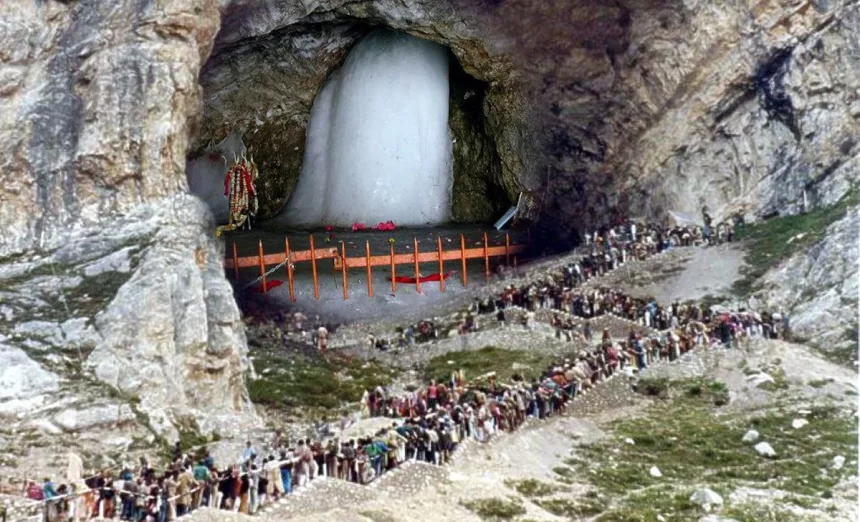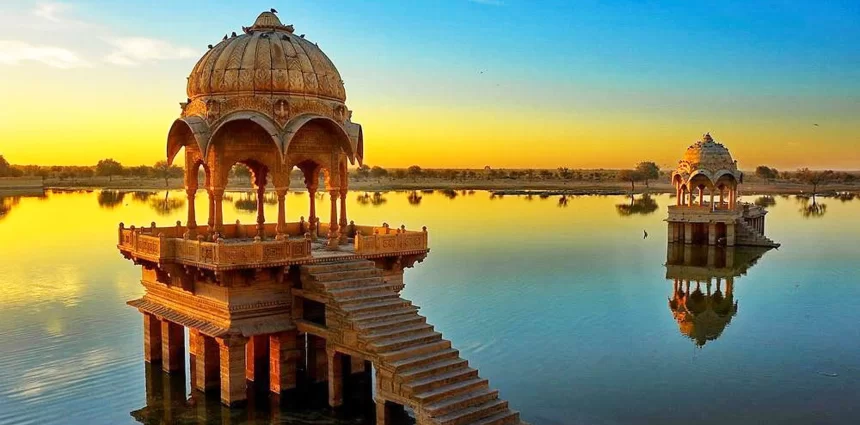Amarnath Yatra 2025: Ultimate Guide to the Sacred Pilgrimage
Plan your Amarnath Yatra 2025 with our detailed guide! Learn about registration, routes, weather, food, and tips for a spiritual journey to the Amarnath Cave.

Amarnath Yatra 2025: A Spiritual Odyssey to the Abode of Lord Shiva
Welcome, fellow wanderers, to another soul-stirring adventure on TheGlobalRoamer! Today, we embark on a sacred journey to the Amarnath Cave, nestled in the majestic Himalayas of Jammu and Kashmir, India. The Amarnath Yatra 2025 is not just a pilgrimage; it’s a transformative experience that blends devotion, physical endurance, and the raw beauty of nature. Whether you’re a first-time pilgrim or a seasoned yatri, this comprehensive guide covers every detail you need to plan your spiritual odyssey, from registration to routes, weather, food, and more. Let’s dive into the divine!
About the Amarnath Yatra
The Amarnath Yatra is one of Hinduism’s most revered pilgrimages, drawing thousands of devotees annually to the holy Amarnath Cave, perched at an altitude of 3,888 meters (12,756 feet) in the South Kashmir Himalayas. The cave houses a naturally formed ice Shivling, believed to be a manifestation of Lord Shiva. Accessible only during a brief summer window (July to August), the yatra coincides with the Hindu month of Shravan, culminating on Shravan Purnima (Raksha Bandhan). In 2025, the yatra will run from July 3 to August 9, spanning 39 days, offering pilgrims a chance to seek moksha (liberation) and divine blessings.
The journey is both spiritually enriching and physically demanding, traversing rugged terrains, steep climbs, and unpredictable weather. But the sight of the ice Shivling, set against the serene, snow-clad mountains, makes every challenge worthwhile. As a global roamer, this pilgrimage is a unique blend of adventure, faith, and cultural immersion.
Registration Process for Amarnath Yatra 2025
Registration is mandatory for all pilgrims, and the Shri Amarnathji Shrine Board (SASB) oversees the process to ensure safety and manage the daily limit of approximately 15,000 yatris (excluding those using helicopters). Here’s a step-by-step guide to securing your permit:
Online Registration
- Start Date: Registration opens on April 14, 2025.
- Website: Visit the official SASB website (jksasb.nic.in).
- Steps:
- Navigate to “Online Services” and select “Yatra Permit Registration.”
- Read and accept the guidelines.
- Fill in personal details: name, age, gender, address, mobile number, Aadhaar number, and preferred yatra date and route (Baltal or Pahalgam).
- Upload a recent passport-sized photograph (JPG/JPEG, max 1MB) and a Compulsory Health Certificate (CHC) in PDF format (max 1MB).
- Verify your mobile number via OTP.
- Pay the registration fee of INR 220 (subject to change) using online payment options.
- Download your Yatra Permit after payment confirmation, which may take 4–24 hours.
- Note: One mobile number can register up to four pilgrims. The permit is non-editable and non-refundable.
Offline Registration
- Start Date: Begins on April 14, 2025, at 446 designated bank branches (Punjab National Bank, Jammu & Kashmir Bank, YES Bank, SBI, ICICI).
- Locations: Key centers in Jammu include Vaishnavi Dham, Panchayat Bhawan, and Mahajan Hall. Tokens are distributed three days before the chosen yatra date.
- Steps:
- Download the registration form from the SASB website or obtain it at the bank.
- Complete the form with personal details and attach a CHC and four passport-sized photographs.
- Submit the form, CHC, and a valid photo ID (Aadhaar, passport, etc.) at the bank.
- Pay the fee (INR 150–220, varies by bank).
- Collect your Yatra Permit and confirmation slip.
- Visit Saraswati Dham the next day for a medical check-up and to finalize registration.
- Group Registration: Available for groups of five or more. The group leader submits a single application, but each member receives an individual permit.
Compulsory Health Certificate (CHC)
- Requirement: A CHC, issued by SASB-authorized doctors or institutions, is mandatory to confirm physical fitness for the high-altitude trek. It must be issued on or after April 8, 2025, with the doctor’s attestation and photograph.
- Where to Get It: Check the SASB website for a state-wise list of authorized doctors/hospitals.
- Age Limits: Pilgrims must be between 13 and 70 years old. Pregnant women over six weeks are not permitted.
RFID Card
- Mandatory: Every registered yatri must collect a Radio Frequency Identification (RFID) card from designated centers in Jammu or Kashmir after eKYC-based biometric authentication.
- Purpose: Enhances safety and security by tracking pilgrims. Wear the RFID tag around your neck at all times during the yatra.
- Collection: Carry your Aadhaar card or other valid ID for verification.
Tips for Registration
- Register early, as slots are allocated on a first-come, first-served basis.
- Double-check all documents before submission to avoid delays.
- For NRIs or foreign nationals, additional documentation (e.g., passport) is required. Contact the SASB for specific guidelines.
Permissions and Guidelines
- Yatra Permit: Issued upon registration, it specifies the route (Baltal or Pahalgam) and date. Pilgrims can only cross Access Control Gates (ACG) on the designated day and route.
- RFID Card: No yatri is allowed beyond the ACG without an RFID card.
- Environmental Guidelines: Plastic use is banned to preserve the fragile Himalayan ecosystem. Avoid littering and follow SASB instructions to prevent pollution.
- Do’s:
- Don’ts:
Weather Conditions
The Amarnath region’s high-altitude climate is unpredictable, with temperatures ranging from -5°C to 15°C during the yatra season.
- July: Milder days (10–15°C) but cold nights. Sudden rain or snowfall is common.
- August: Slightly warmer but with potential for heavy rain, especially on the Pahalgam route.
- Challenges: Low oxygen levels, sub-zero temperatures at higher altitudes, and slippery trails due to rain or melting snow.
- Preparation:
Food and Dietary Guidelines
The SASB enforces strict dietary guidelines to ensure health and cleanliness at high altitudes:
- Recommended Diet: Light, sattvik (pure vegetarian) meals that are easy to digest, such as rice, dal, khichdi, fruits, and nuts. High-carb foods (bread, potatoes) combat fatigue and maintain energy.
- Langar Services: Non-profit organizations and volunteers set up free community kitchens (langars) at key points like Nunwan, Chandanwari, Sheshnag, Panjtarni, and Baltal. These serve hot meals, tea, and snacks, fostering a sense of community.
- Other Options:
- What to Carry: Pack high-energy snacks (chocolates, energy bars) and a reusable water bottle. Drink at least 5 liters of water daily to prevent dehydration.
- Restrictions: Non-vegetarian food, alcohol, and caffeinated drinks are prohibited to avoid health complications.
Travel Options and Routes
The Amarnath Cave is accessible via two primary routes: the shorter Baltal route and the traditional Pahalgam route. Both start from base camps reachable by air, rail, or road.
Getting to the Base Camps
- By Air: Fly to Srinagar International Airport (141 km from Pahalgam, 90 km from Baltal). Taxis and buses connect to the base camps.
- By Train: Jammu Tawi Railway Station is the nearest railhead (250 km from Srinagar). From Jammu, take buses or taxis to Srinagar, Pahalgam, or Baltal.
- By Road: The Jammu and Kashmir State Road Transport Corporation (JKSRTC) operates deluxe and semi-deluxe buses from Jammu and Srinagar to Pahalgam and Baltal. Private taxis are also available.
- Suggested Itinerary:
Baltal Route
- Distance: 14–16 km from Baltal to the cave.
- Duration: 1–2 days round trip.
- Description: Steeper and more challenging, ideal for fit pilgrims. The trek passes through Domali, Barari, and Sangam, with stunning views of glaciers and rugged peaks.
- Pros: Faster, suitable for those with limited time.
- Cons: Physically demanding, less scenic than Pahalgam.
- Base Camp: Baltal offers tented accommodations and basic facilities. Stay in nearby Sonamarg (14 km away) for better lodging.
Pahalgam Route
- Distance: 36–48 km from Pahalgam to the cave.
- Duration: 3–5 days round trip.
- Description: Longer but gentler, with scenic stops at Chandanwari, Sheshnag, and Panjtarni. The route winds through lush valleys, meadows, and the Lidder River, offering an immersive experience.
- Pros: Ideal for elderly pilgrims or those seeking a gradual climb.
- Cons: Time-intensive, requires more stamina for multi-day trekking.
- Base Camp: Pahalgam is a picturesque town with hotels, guesthouses, and tented camps.
Helicopter Services
- Availability: From Neelgrath (Baltal) or Pahalgam to Panjtarni, followed by a 6 km trek to the cave.
- Booking: Opens closer to the yatra; book online via the SASB website or authorized operators. Each credit/debit card can book up to five tickets.
- Cost: Approximately INR 20,000–25,000 per person (including a 5-day tour with meals and transfers).
- Pros: Saves time, ideal for senior citizens or those with physical limitations.
- Cons: Subject to weather conditions; requires a separate CHC.
- Tip: Book early, as slots are limited. Carry warm clothing for the trek from Panjtarni.
Support Services
- Porters, Ponies, and Palkis: Available for hire at government-notified rates (updated on the SASB website). Ideal for elderly or less fit pilgrims.
- Medical Facilities: Medical Aid Centers (MACs) and Emergency Aid Centers (EACs) are stationed every 2 km, offering first aid, oxygen, and emergency care.
- Security: Army troops and volunteers ensure safety, assist lost pilgrims, and manage crowds.
Accommodation
- Base Camps: Baltal and Pahalgam offer prefabricated huts (INR 250–375/night) and private tents (INR 250–1,000/night) with basic bedding and sanitation.
- En Route: Tented camps at Nunwan, Chandanwari, Sheshnag, and Panjtarni provide shelter. Book via the SASB or private contractors.
- Tips:
Physical and Mental Preparation
The Amarnath Yatra is a high-altitude trek requiring physical and mental resilience:
- Physical Fitness: Start a daily 4–5 km walk and practice pranayama (deep breathing) a month prior to improve oxygen efficiency.
- Acclimatization: Spend a day in Srinagar or Pahalgam to adjust to the altitude.
- Mental Preparation: Embrace the spiritual significance of the journey. Meditate or read about Lord Shiva to deepen your connection.
- Packing List:
Cultural and Spiritual Insights
The Amarnath Yatra is steeped in mythology. Legend has it that Lord Shiva revealed the secret of immortality to Goddess Parvati in this cave, and the ice Shivling symbolizes his divine presence. The cave was discovered by a shepherd, Buta Malik, who found gold in a bag given by a saint, leading him to the sacred site.
Respect local Kashmiri culture by dressing modestly and engaging politely with porters, vendors, and volunteers. Participate in langar services or evening aartis (prayers) at the cave for a deeper spiritual experience. The sense of camaraderie among yatris, regardless of background, is a highlight of the journey.
Safety and Emergency Tips
- Altitude Sickness: Symptoms include headaches, nausea, or dizziness. Descend immediately and seek medical help if symptoms persist.
- Emergency Contacts: Carry SASB helpline numbers and note medical camp locations.
- Travel in Groups: Stay with your group or porter to avoid getting lost.
- Stay Updated: Follow SASB guidelines and weather alerts.
- Insurance: SASB provides insurance coverage for pilgrims and service providers.
Budget and Costs
- Registration Fee: INR 150–220 per person.
- Travel: INR 5,000–10,000 (flights to Srinagar, buses/taxis to base camps).
- Helicopter Package: INR 20,000–25,000 (includes meals, transfers, and sightseeing).
- Accommodation: INR 250–1,000/night for tents/huts.
- Food: Mostly free at langars; budget INR 500–1,000 for additional snacks.
- Porters/Ponies: INR 2,000–5,000 (varies by route and load).
- Total Estimate: INR 10,000–30,000 per person (excluding flights), depending on travel mode and services.
Why the Amarnath Yatra?
For global roamers, the Amarnath Yatra is more than a pilgrimage—it’s an adventure that tests your limits and rewards you with profound peace. The rugged Himalayan trails, the camaraderie of fellow yatris, and the divine aura of the ice Shivling create memories that last a lifetime. Whether you trek through the scenic Pahalgam route, brave the steep Baltal path, or opt for a helicopter ride, the journey purifies the soul and connects you with the eternal.
Final Tips for TheGlobalRoamer
- Book early for registration, accommodations, and helicopter services.
- Respect the environment and local traditions.
- Prepare physically and mentally for the high-altitude challenge.
- Capture the journey through photos (where permitted) but stay present in the moment.
- Check the SASB website (jksasb.nic.in) for real-time updates on schedules, weather, and bookings.
Embark on this sacred sojourn with an open heart and unwavering devotion. May Lord Shiva bless your journey with strength, peace, and enlightenment. Har Har Mahadev! Share your Amarnath Yatra stories with us at TheGlobalRoamer—we can’t wait to hear about your spiritual adventure!
Happy roaming,
TheGlobalRoamer Team





















